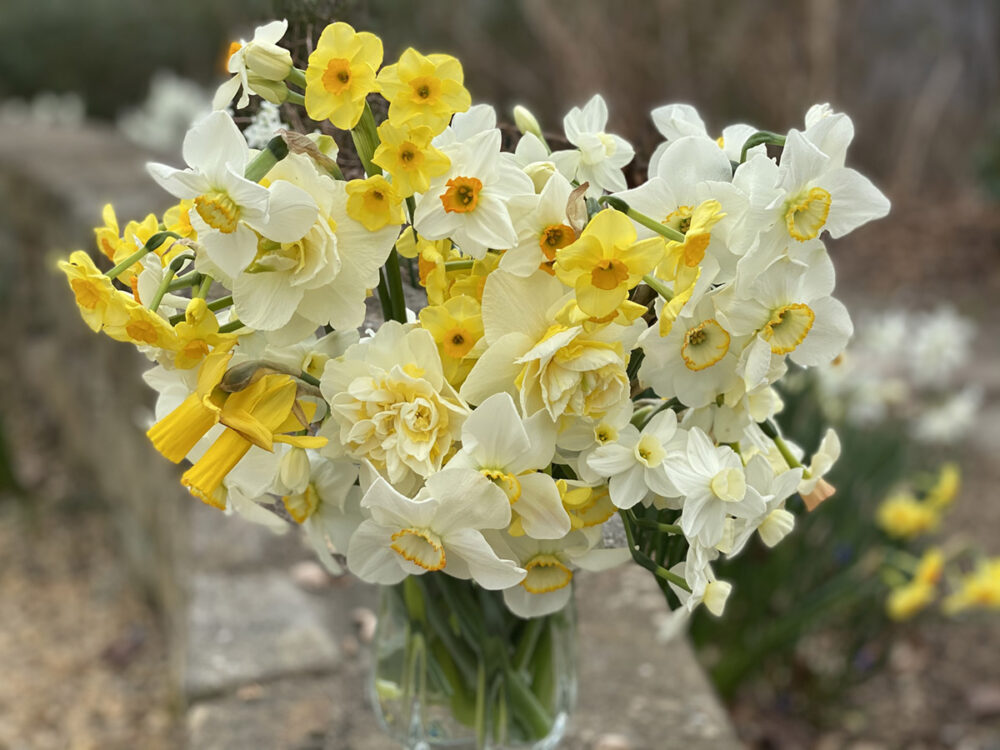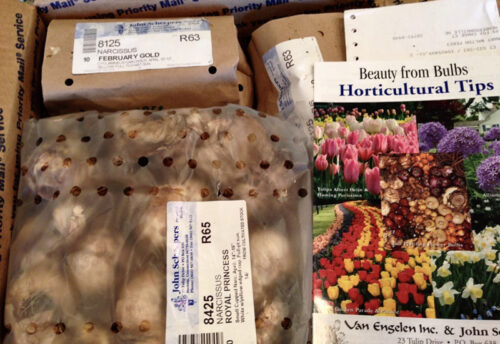
The first time I met Jill was at my front door when she and her husband came to dinner. There she stood on a blustery, late-winter evening with a jam jar of daffodils in her hand. They were small blossoms, delicate and yellow. I don’t remember which daffodils they were, but that bouquet lives on in the soft focus of a happy memory. Here was a gardener who was bringing me her first spring treasures. She knew how special those blooms were—and so did I. I looked at that bouquet and declared, “We are going to be great friends!”
That evening we talked of gardening and daffodils, her special passion and mine. “Daffodils are the most welcome flowers of the year,” I said, and Jill chimed in with me “because they are the first!”

Winter in the North Carolina mountains is beautiful, with muted colors in a bare landscape of tans, browns, grays, evergreens, and always, in the distance, the gray-blue of the mountains. But when those first yellow daffodils appear, how exciting it is to see such a bright color. It is one of the best moments of the gardening year.
Finding the Best Location
When I first moved to the mountains, I anticipated that wintertime would be austere—not to say bleak—so I ordered hundreds of the earliest daffodils, ‘Rijnvelds’ Early Sensation’ and ‘February Gold.’ I planted them on the northeast side of the house, not far from the dining room window, so I could enjoy their yellow splash on dull days.


They bloomed well the first year but then petered out in the following years. It took a long time to understand my mistake: I had planted the bulbs maybe 15 feet from the house, but it was close enough for the low winter sun to throw the long shadow of the house over the daffodils. In short, they didn’t get enough winter sun to bloom well. In addition, I had planted them beneath trees with root competition.
I dug up the bulbs and transplanted them below the house on the southwest side. Here there are no trees, and the sun-warmed stone of the house shelters them from the cold north wind and radiates warmth to bring them to flower early. The bulbs are planted at the top of a retaining wall, an ideal spot for daffodils because they must have excellent drainage. This new location works so well that the daffodils now bloom profusely in December, a feat so astonishing that when I say these bouquets grew in my garden, people can hardly believe me. In fact, I suspect some of them don’t.

Glorious yellow in the house on gray winter days, what an extravagance! I once heard the great British flower arranger, Sheila MacQueen, say that a flower arrangement brings as much life to a room as a fire sparkling in the grate. Bright yellow daffodils bring double life to a room: They bring the cheer of the flowers plus the color of the fire too.
The daffodils in their new location below the house are in a cutting garden; I cut every blossom for the house. The luxury of a cutting garden allows me to leave all the daffodils in the main garden to enjoy in place. The main garden is above the house, a good distance from the dining room and filled with winter sun. When cold mountain fogs settle over the main garden, the glow of yellow daffodils through the mist is magical.
Planting Tips

Because yellow makes such an impact in gray weather, I favor yellow daffodils. If you have ever seen the swaths of yellow daffodils in London parks in February, you will agree. Plant one variety in a drift, large or small. Then plant groupings of other daffodil varieties in other places in the garden.
I don’t like the mixtures of different daffodil varieties that bulb companies offer in order to extend the blooming season; they just dribble out spotty color over a long period. What’s the point of that? It’s much better to pack a punch with one variety in one color.
We don’t need a garden the size of Hyde Park to rejoice like Wordsworth in the spring. Instead, tuck groupings of daffodils into your mixed shrub and perennial borders. Twelve bulbs planted together (or more if you have the space) make a joyful effect. Arrange them in a cluster—not a straight line. This advice is for areas in the garden that you view up close, along a path perhaps. This advice does not apply to daffodils viewed from a distance, from a moving car, or from across a large lawn. To make an effect at a distance, plant in a generous sweep of hundreds of daffodils.

Observe the spacing recommendations that come with the bulbs. Some people plant two or three bulbs close together hoping for a bigger show, but this allows the roots of the bulbs to strangle each other. When the daffodils finish blooming, you must leave the foliage to wither in place because the foliage is providing energy to build up the bulb for next year’s bloom. Jill plants early daffodils at the back of the bed, midseason daffodils in front of those, then late season daffodils in front of those. The idea is that the subsequent blooms hide the dying foliage of the earlier blooms behind them.
The only difficult aspect of growing daffodils is remembering that you must plant them in the fall. When the world is festive with daffodils in the spring, it’s too late to plant them. That’s why bulb companies send out catalogs in the spring, hoping your enthusiasm leads you to order the bulbs in the spring, receive them, and plant them in the fall to enjoy the following spring. It is an awkward time lag, especially for the beginner.

Daffodil Varieties
With careful selection of varieties and attention to where I plant them, I have daffodils blooming in my garden from December until May, beginning with ‘Rijnveld’s Early Sensation’ and ‘February Gold’ and ending with ‘Pheasant’s Eye’ and ‘Actaea.’ What is more fun than studying the John Scheeper’s Bulb catalog, dreaming of daffodils and which ones to try next?
I prefer a yellow and white palette with forsythia and witch hazel complementing the daffodils. As the days grow brighter, I choose daffodils that are white or a softer shade of yellow. And what a choice you have! There are fat double daffodils like ‘Lingerie,’ which Scheepers describes as 4-inch double flowers “with snow-white petticoat layers interspersed with lemon-yellow petaloid whorls.” And what about ‘White Lion’: a 3-inch gardenia-like bloom that “opens pale yellow and matures to creamy white with shorter yellow petal segments at its frilled double center.” Double daffodils deliver!
So do miniature daffodils like ‘Baby Moon,’ large-cupped daffodils like ‘Avalon,’ and multiple flowers per stem like ‘Thalia.’ Oh what spring delights are in store for you—if you plant them now in the fall.
Click the arrows (or swipe if on a mobile device) to see more
Text and photography Mary Walton Upchurch © 2020
Author and gardening enthusiast Mary Walton Upchurch grew up in Montgomery, Alabama, and earned a degree in landscape architecture from the Harvard Graduate School of Design. For more than 30 years, she practiced in Montgomery as an award-winning landscape architect and wrote garden articles for a local publication. Today, she lives in western North Carolina, where she built a home and garden on top of a mountain with panoramic views of the Blue Ridge Mountains.






